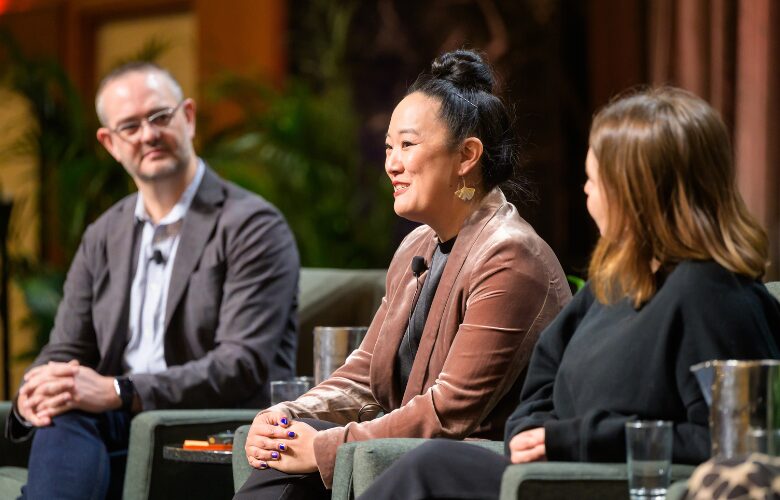Immersive Programming – APAP|NYC 2025

Immersive Programming: It’s for You. It’s for Everyone. And It’s the Future.
As arts organizations search for new ways to build community, attract diverse audiences, and deepen impact, immersive programming has emerged as a vital and evolving frontier. At the APAP|NYC 2025 session, “Immersive Programming: It’s for You. It’s for Everyone. And It’s the Future,” five leaders at the forefront of this field shared examples, insights, and tangible strategies for how presenters and producers can begin (or expand) their immersive journey. APAP is pleased to share the content of this important conversation through the article below and the session’s video recording, continuing its mission to equip the arts community with the necessary tools to engage in meaningful advocacy for the arts.
Moderator Courtney Ozaki, creative producer at the Denver Center for the Performing Arts’ Off-Center program, opened the session by acknowledging the complexity of the term “immersive.” It isn’t one-size-fits-all—it spans solo headphone experiences, large-scale interactive worlds, virtual reality installations, and intimate encounters that blur the lines between performer and participant. But its promise is consistent: to center the audience in the storytelling and invite deeper connection, co-creation, and community.
Ozaki’s own immersive production, “Zoto,” explored five generations of Japanese American women through a multisensory journey rooted in family history and folklore. Whether site-specific or virtual, Ozaki emphasized that immersive work allows audiences to feel stories—not just watch them.
Jon Faris, Managing Director for AMS Planning and Research, framed the conversation within current social realities. Citing recent reports from “The Atlantic” and the U.S. Surgeon General on rising loneliness and reduced in-person interaction, Faris argued that immersive programming has potential as an antidote to isolation.He invited presenters to think of immersive experiences not as fringe experiments, but as a core part of the future arts ecosystem. “We’re not in 2025,” he said. “We’re in 2030. The future is now.”
Ozaki shared a variety of immersive projects:
- Blind Date, a one-on-one theatrical experience at a contemporary art museum
- Darkfield, a pitch-dark sonic journey inside shipping containers
- Sweet & Lucky, a narrative performance inside an antique store maze
- Theater of the Mind, co-created by David Byrne, blending neuroscience and live performance
These experiences take place in unexpected locations—historic buildings, city streets, virtual reality headsets—and offer multiple access points for different audience types. Remarkably, 50% of Off-Center’s immersive audiences are new to the organization, and younger than typical theatergoers.
Beata Calińska, Associate Director of Digital Innovation at LA’s The Music Center, discussed AR, VR, and hybrid projects that serve LA County’s vast and diverse population. Her team’s initiatives—from augmented reality filters in public parks to co-created future-culture labs—activate community voices while reimagining how public spaces can be used for art. Their monthly Black Bar Social series blends tech, discussion, and celebration to invite participation without pressure.
Culture House Immersive Founder and Executive Producer Mikhael Tara Garver emphasized the need for immersive involvement, not just immersive environments. Her studio works with artists and venues to craft experiences that offer narrative agency—where audiences don’t just observe, but shape what unfolds. From sensory storytelling to bus-ride performances, her team is helping build a pipeline of high-quality, scalable immersive works that fit different types of venues.
Tom Gabbard, President and CEO of Blumenthal Arts in Charlotte, NC, shared how his team transformed a warehouse into Bloom Studios, a flexible space for immersive events. Their launch project, “Immersive Van Gogh,” reached over 80% new ticket buyers and generated $16 million in revenue. Their nimble, scrappy approach uses shipping container bathrooms, mobile HVAC, and modular walls to keep costs low and adaptability high. “We need to go where people’s interests are,” Gabbard said. “And immersive helps us do that.”
Immersive work draws multigenerational, multicultural, and adventure-seeking audiences, offering a participatory and often transformational alternative to traditional formats. Many panelists noted that these experiences can reach people who feel disconnected from mainstream arts spaces—whether due to cultural, generational, or physical access barriers.
To start, presenters were encouraged to:
- Start small with scalable, self-contained projects like “Darkfield” or interactive installations
- Use existing spaces creatively, including black box theaters, parking garages, even storage rooms
- Collaborate with artists and producers who can tailor work to local communities
- Set expectations clearly with audiences and internal teams (FAQs, onboarding emails, transparent language)
- Build community before scaling up, ensuring that immersive work reflects and welcomes local voices
This field is still in development—and that’s a good thing. The panelists invited arts leaders to experiment, share knowledge, and collectively build an immersive ecosystem. Through convenings like “The Immersive Immersive” (a national gathering initiated by several panelists), online forums, and creative partnerships, organizations can tap into a growing movement to transform how the arts are created, experienced, and shared.
Immersive programming doesn’t replace traditional arts—it adds to it. It opens doors. It meets people where they are. And most importantly, it reaffirms that being together, creating together, and imagining together is a powerful part of what it means to be human.
Main image: Courtney Ozaki speaking at Immersive Programming session (Photo by Adam Kissick APAP)
Editor's Note: At StageLync, an international platform for the performing arts, we celebrate the diversity of our writers' backgrounds. We recognize and support their choice to use either American or British English in their articles, respecting their individual preferences and origins. This policy allows us to embrace a wide range of linguistic expressions, enriching our content and reflecting the global nature of our community.
🎧 Join us on the StageLync Podcast for inspiring stories from the world of performing arts! Tune in to hear from the creative minds who bring magic to life, both onstage and behind the scenes. 🎙️ 👉 Listen now!